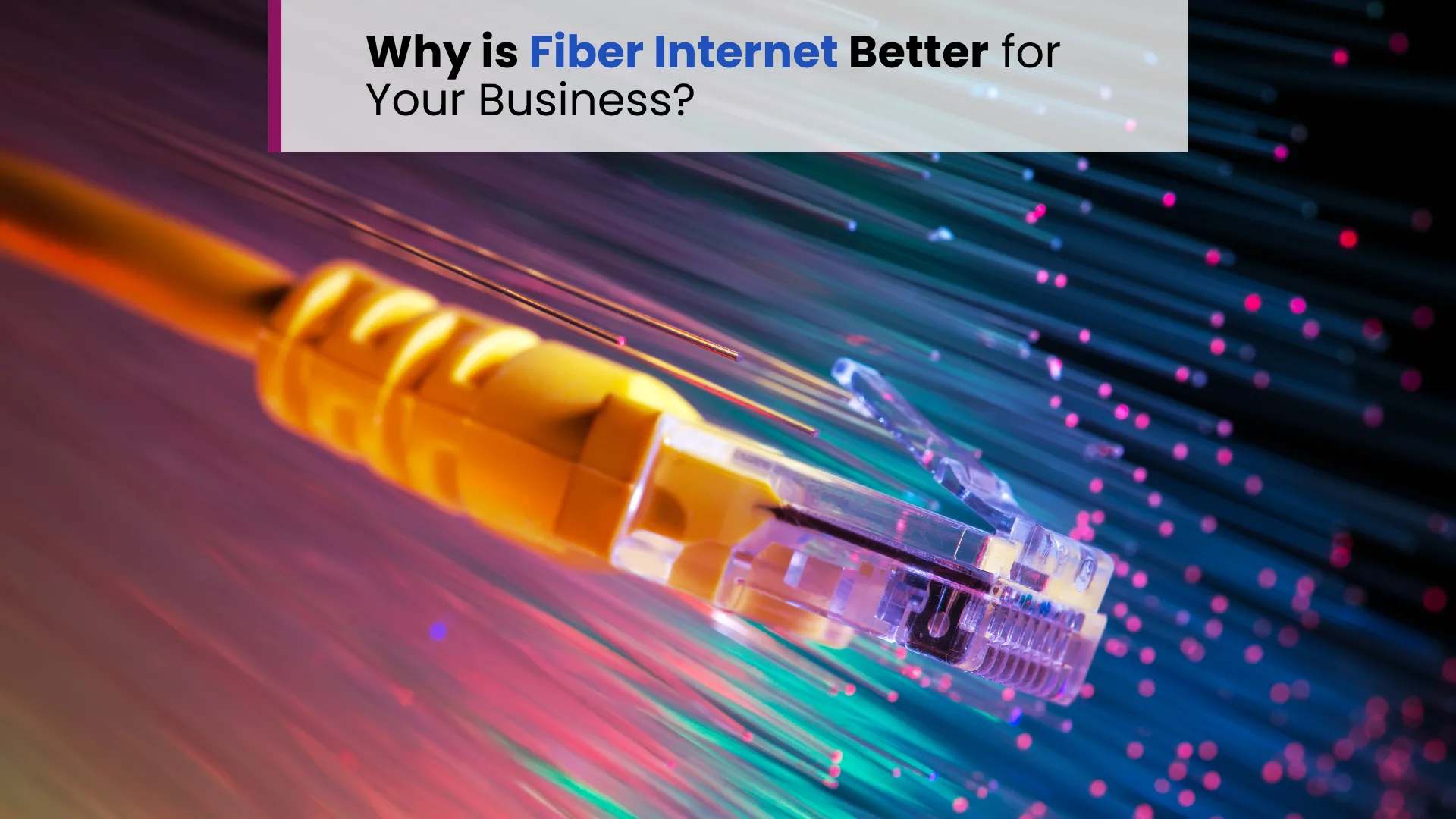
February 25, 2025
Why is Fiber Internet Better for Your Business?
Every business is on the hunt for reliable, high-speed internet. But how many actually find it?
Many struggle because they don’t fully understand what to look for or how to choose the right one. The result? Frustration, downtime and missed opportunities. So, what key factors should you consider to ensure you select the best type of internet service for your business?
Fiber internet, which uses advanced technology to send data as light through special cables, stands out as the top choice for connectivity. Unlike older internet options, fiber internet offers exceptional speed, reliability, and flexibility, making it an essential tool for businesses looking to stay competitive and efficient.
In today's article, we will talk about fiber internet, how it works and why it is better for your business than any other internet.
What is Fiber Internet?
Fiber internet is a type of high-speed internet that uses fiber optic cables to deliver data. These cables are made of very thin strands of glass or plastic that carry data as pulses of light. This method allows fiber internet to offer extremely fast speeds and reliable connections.
Fiber internet is known for its ability to handle large amounts of data quickly, making it ideal for activities like streaming, video conferencing, and using cloud-based applications. It also has low latency, meaning there is minimal delay in data transmission, which enhances performance and user experience.
Difference Between Fiber Internet and Other Types of Internet
Fiber Internet:
- Offers the fastest speed and best performance. It ensures seamless streaming, quick downloads, and rapid data uploads.
- Fiber optic technology provides minimal latency, meaning data travels almost instantly. This characteristic is crucial for activities that require real-time communication, such as video conferencing and online gaming, as it minimizes delays and buffering.
DSL (Digital Subscriber Line):
- DSL internet is slower than fiber. The actual speed depends on the distance from the provider’s central office. The further you are, the slower your connection may become.
- This often experiences higher latency, particularly over long distances or when subjected to interference from electronic devices. This can result in noticeable delays during online activities, impacting tasks like video streaming and gaming.
 Internet Connection.webp)
Cable Internet:
Cable internet is often comparable to DSL, but it varies depending on the number of users in the area. It can get slower when many people are using the connection at the same time, as it is shared with neighbors.
Satellite Internet:
- High latency is a significant drawback of satellite internet. This is because signals must travel vast distances from the Earth to the satellites, causing noticeable delays.
- Satellite connections are particularly vulnerable to weather conditions.
Why is Fiber Internet Better for Your Business?
Fiber Internet offers several advantages for businesses compared to other types of Internet connections, such as DSL or cable. Here’s how it stands out:
1. High-Speed Performance:
Bandwidth: Fiber Internet provides much higher bandwidth, allowing for faster upload and download speeds. This is crucial for businesses that rely on large file transfers, video conferencing, cloud services, and other high-bandwidth applications.
Symmetrical Speeds: Fiber often offers symmetrical upload and download speeds, which means that both upload and download rates are equally fast. This is beneficial for businesses that need to send large amounts of data, run online backups, or use cloud-based applications.
2. Reliability and Stability:
Lower Latency: Fiber-optic networks have lower latency, resulting in faster response times for online activities. This is essential for real-time applications like VoIP (Voice over Internet Protocol) and live streaming.
Reduced Interference: Fiber cables are less susceptible to electromagnetic interference compared to copper cables, leading to more stable and consistent connections.
3. Scalability:
Future-Proofing: Fiber Internet has a higher capacity for future upgrades. As business needs grow and data demands increase, fiber infrastructure can often be upgraded to support higher speeds without major overhauls.
4. Enhanced Security:
Data Protection: Fiber-optic cables are harder to tap into without detection compared to copper cables, offering better security for sensitive business data. This makes fiber a preferred choice for companies handling confidential information.

5. Increased Productivity:
Better Collaboration: Fast and reliable Internet enables smoother collaboration tools, such as cloud-based project management software, real-time editing, and video conferencing, which can improve overall productivity.
Support for Multiple Users: Fiber Internet can handle more simultaneous users and devices without a significant drop in performance, making it ideal for businesses with many employees or multiple locations.
6. High-Volume Data Handling:
Large Data Transfers: Businesses that handle large amounts of data, such as media companies or data centers, benefit from fiber’s high capacity and speed for transferring and accessing data quickly.
7. Improved Customer Experience:
Fast Response Times: A high-speed and stable fiber connection ensures quick website loading times, seamless customer interactions, and efficient online transactions. Whether handling customer support chats, processing online orders, or managing cloud-based services, fiber internet helps businesses deliver a smooth and responsive experience.
Related Blog: How to Choose the Right Internet Plan for Your Business?
How Does Fiber Internet Work for Businesses?
Fiber Internet works by using fiber-optic cables, which are made of thin strands of glass or plastic, to transmit data as light signals. This is fundamentally different from traditional copper-based business internet connections, which use electrical signals.
The use of light allows fiber-optic cables to carry significantly more data over longer distances without degradation, making them ideal for high-speed and reliable business networks. Here’s how it works:
Fiber-Optic Cables: The backbone of fiber Internet is the fiber-optic cable, consisting of thin strands of glass or plastic fibers that transmit data as pulses of light. This enables businesses to access ultra-fast and stable connectivity, essential for handling large data transfers, cloud computing, and real-time communications.
Transmission of Data: Data is converted into light signals using a laser or LED (Light Emitting Diode) transmitter. These signals travel through fiber-optic cables at incredibly high speeds. Since light travels faster than electrical signals and doesn’t degrade as quickly over long distances, fiber-optic connections provide businesses with uninterrupted, high-speed Internet and minimal signal loss.
Optical Network Terminal (ONT): At the business premises, an Optical Network Terminal (ONT) is installed to convert the light signals from the fiber-optic cable into electrical signals that the business network can use. The ONT ensures a seamless connection between the fiber network and internal business systems, such as workstations, VoIP services, and cloud applications.
Internet Service Provider (ISP): The fiber-optic cables connect to a central hub managed by the Internet Service Provider (ISP). The ISP’s high-speed backbone connects businesses to the broader Internet, ensuring fast and secure data transfer between employees, clients, and cloud-based services.
Business Network Router: After the ONT converts the light signals into electrical signals, the connection is distributed through a business-grade router. This router directs traffic efficiently across multiple devices, ensuring seamless connectivity for business operations, including video conferencing, remote work, and high-bandwidth applications.
High-Speed Performance: Fiber Internet delivers superior performance compared to traditional copper-based business connections (such as DSL or cable) due to its higher bandwidth and lower latency. This results in faster download and upload speeds, more reliable connections, and a smoother experience for cloud-based software, large file transfers, and digital collaboration.
Let us know you that Carnival Internet delivers exceptional, high-speed dedicated internet solutions meticulously crafted to empower businesses of all sizes with seamless connectivity and unmatched performance.
But don’t just take the word for it—dive into the experience of a delighted customer who’s reaping the rewards of partnering with Carnival Internet!
In conclusion, fiber internet is an excellent choice for businesses needing fast, reliable, and flexible connectivity. It delivers superior speed and capacity, making it ideal for tasks like video meetings and large file transfers.
Compared to older types like DSL, cable, and satellite, fiber offers better performance, lower latency, and enhanced security. Its ability to handle high data volumes and support many users makes it a smart investment, ensuring your business stays competitive and efficient in today’s digital landscape.